MXA’S 2012 YAMAHA YZ450F MOTOCROSS TEST: THE MUFFLER CORKS IT UP AND THE MAPPING FREES IT UP
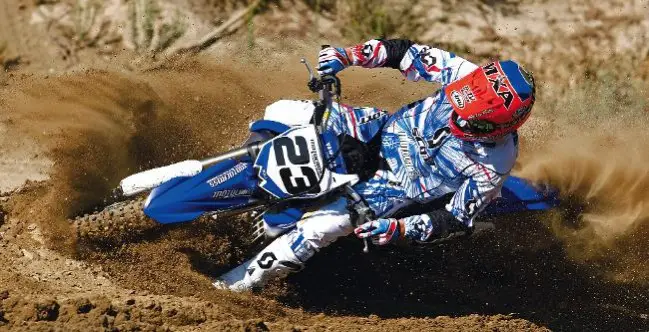
Q: FIRST AND FOREMOST, IS THE 2012 YZ450F BETTER THAN THE 2011 YZ450F?
A: That depends on how you define “better.” It is quieter and the rims are black, but apart from that, the modifications are of the garden-variety type?new mapping, new valving, new muffler and new tires. The 2011 model was a warmed-over 2010 YZ450F, but the 2012 gets more power thanks to an odd combination of slowing it down and speeding it up.
Q: WHAT ARE THE MAJOR CHANGES THAT YAMAHA MADE TO THE 2012 YZ450F?
A: There aren’t any major changes, but here is the complete list of minor changes:
(1) Ignition. The fuel mapping and ignition timing were optimized (although they were only changed to perk up the powerband after the restrictive new muffler dampened the low-end throttle response).
(2) Muffler. The 2012 muffler is 42mm longer and has a 3mm-smaller core diameter than last year’s. We’ve come a long way from the ice-cream-cone muffler of 2009.

(3) Shift fork. The locating pins on the shift forks (two of the three) have been changed to circlips to increase shift-bar rigidity for more precise shifting from second to third. The shift fork is now free to center itself, and the shift bar is more rigid, because it doesn’t have the hole drilled in it that the pinned shift bars had.
(4) Rims. Last year, the rims were silver (although they were black anodized in Europe). For 2012, they are black around the globe. This is more related to production efficiency than any philosophy that black rims are better than silver rims.
(5) Forks. The 48mm KYB Speed Sensitive System (SSS) front forks have been revalved to increase low-to-mid compression damping.
(6) Shock. The KYB 50mm shock has revised rebound damping, a new rebound adjuster oil passage and improved valving with less low-speed rebound and more high-speed compression.
(7) Tires. Last year, the YZ450F came with an awesome Dunlop D756 rear tire and an atrocious D742FA front. For 2012, both ends are shod with Dunlop Geomax MX51 tires.
Q: IS THE 2012 YAMAHA YZ450F FASTER THAN THE 2009, 2010 & 2011 YZ450F?
A: Even though the 2012 YZ450F engine is mechanically the 2011 engine, and the 2010 engine?it is faster than the 2011 and the 2010. It has a better overall powerband.
But, if we want to find a true comparison, it is best to go back to the carbureted 2009 YZ450F because that was a totally different engine design. So, is the 2012 Yamaha YZ450F faster than the 2009 Yamaha YZ450F? Yes, but the 2009 YZ450F was an easy target. It was stifled by its restrictive ice-cream-cone muffler and mellow cams; thus the 2010?2012 YZ450F engine is night-and-day better than its older brother. Off the bottom, the 2012 engine is much stronger (almost guaranteed when you fuel-inject a 450cc engine). It doesn’t have the top-end over-rev of the 2009, but that wasn’t all that impressive anyway.
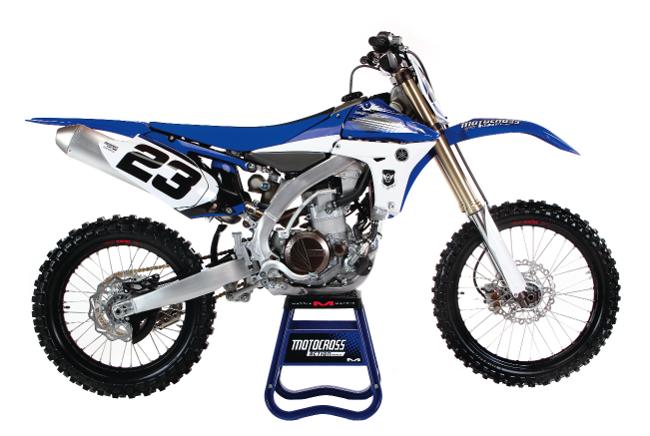
2012 Yamaha YZ450F: Yamaha didn’t make a lot of changes for 2012, but the changes they made to the powerband and suspension damping did make the bike better.
Q: DID YAMAHA MAKE ANY CHANGES TO THE POWERBAND FOR 2012?
A: Before we discuss the powerband, we need to talk about what happens when you make the muffler almost 2 inches longer and squeeze the perf core down from 33mm to 30mm. There are two results:
(1) Powerband. The increase in back pressure has a negative effect on low-end throttle response. Plus, the combination of a longer canister and smaller core slows the revs down.
(2) Sound. With more packing and a smaller outlet, the 2012 Yamaha YZ450F is quieter than the 2011 model.
You don’t need Dick Tracy to tell you that the new muffler is not a plus when it comes to power production. It is a negative. Thankfully, Yamaha tried to mitigate the negative effects of the muffler by changing the ignition timing and fuel mapping.
In order to offset the 2012 muffler, Yamaha advanced the ignition timing at almost every point of the power curve (save for the highest rpm with the throttle wide open). Additionally, they increased the fuel at low rpm (through half throttle). The result was that Yamaha gained back what they lost down low?plus the muffler/mapping manipulation got rid of the overly barky low-end throttle response of the 2010 and 2011 models that most YZ450F riders didn’t like. The combination of restrictive muffler and advanced ignition produces better power than last year. It made more peak power. The rev was slowed down by the muffler and the mapping picks up the pace?the result is a broader feeling powerband.
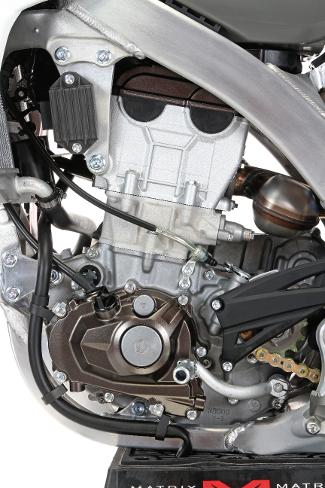 Sideways: Yamaha’s engine program for 2012 consisted of killing the powerband with a restrictive muffler and then livening it up with mapping changes. Surprisingly, it worked. |
Q: IS THE 2012 YZ450F THE FASTEST 450 ON THE TRACK FOR 2012?
A: No. Why not? There is a new sheriff in town. His name is Kawasaki. Kawasaki’s engineers have had a handle on the ins and outs of fuel-injected 450cc motocross bikes since their very first go at EFI (when every other manufacturer floundered). The KX450F is the target that every other fuel-injected engine should shoot for. Not just because the KX450F makes the most horsepower, but because Kawasaki didn’t get caught in the low-to-mid EFI trap that snared the rest of the first generation of fuel-injected 450s. While early EFI versions of the CRF450, RM-Z450 and YZ450F produced tons of barky low-end power, they were flat on top. Not Kawasaki. They had a usable and broad powerband.
Q: HOW DOES THE 2012 YZ450F RUN ON THE DYNO?
A: It produces healthy numbers. Max horsepower is the second best in the class at over 55 horesepower. That’s put it above the KTM 450SXF, Suzuki RM-Z450, Honda CRF450 and KTM 350SXF?although not in the rarefied air of the 2012 KX450F (55.50 horsepower).
Q: WHAT WERE OUR BEST FORK SETTINGS?
A: Yamaha has the best showroom stock suspension sold. Kayaba’s SSS suspension is so good that MXA test riders had no major complaints. The new damping is focused on keeping the forks higher in their stroke so that they have more travel for upcoming bumps and keep the chassis level longer.
For hardcore racing, these are MXA‘s recommended 2012 Yamaha YZ450F fork settings (stock settings are in parentheses):
Spring rate: 0.47 kg/mm
Oil quantity: 355cc
Compression: 10 clicks out (13 clicks out)
Rebound: 9 clicks out (10 clicks out)
Fork leg height: Flush with the cap
Notes: We had no major problems with the YZ450F’s Kayaba SSS forks. We prefer to run the compression setting much stiffer than normal because it helps balance out the chassis and reduces the wiggle.
Q: WHAT WAS OUR BEST SHOCK SETTING?
A: Yamaha revised the rebound damping of the 2012 shock. Last year, the recommended rebound clicker setting was 14 clicks out. This year, it is 17 clicks out. Most MXA test riders slowed the rebound down to 14 clicks out, which would be comparable to the 11 clicks out that we ran in 2011.
For hardcore racing, these are MXA‘s recommended 2012 YZ450F shock settings (stock settings are in parentheses):
Spring rate: 5.7 kg/mm
Race sag: 100mm
Hi-compression: 1-1/2 turns out (1-1/4 turns out)
Lo-compression: 7 clicks out (8 clicks out)
Rebound: 14 clicks out (17 clicks out)
Notes: Most MXA test riders prefer less high-speed compression and more rebound. We also run a longer Pro Circuit shock linkage (although not solely for suspension purposes). We want more adjustment room with the head angle and frame geometry.
Q: HOW DOES THE 2012 YAMAHA YZ450F HANDLE?
A: Most MXA test riders felt that the 2011 YZ450F’s handling was quirky. This was most noticeable on the entrance to turns when the front end wiggled. For 2012 the wiggle has been reduced. Now it’s just irritating. On the plus side, most test riders prefer it to the pre-2010 YZ450F frames that pushed in the center of the corner. Most of MXA‘s efforts with the forks, damping, balance and shock linkage (and Yamaha’s 2012 suspension mods) were aimed at eliminating the YZ-F’s one quirk. Once we found the balance, we had no major issue with the YZ-F’s geometry.

Brief summary: The 2012 Yamaha YZ450F has the best suspension, most reliable engine and it produces competitive power. The brakes, the weight and the airbox don’t add anything to the package.
Q: WHAT DOES THE 2012 YZ450F WEIGH?
A: Make no mistake about it, compared to the Honda CRF450, every other 450cc motocross bike is a Jenny Craig dropout. Happily, the Yamaha YZ450F is lighter than the KTM, Kawasaki or Suzuki. But it’s not light. The Honda is light (231 pounds). The Yamaha weighs 7 pounds more at 238 pounds.
What makes the seven extra pounds on the YZ450F seem so incongruous is that Yamaha went to great lengths to become the poster child for “centralization of mass.” All of the creativity that the engineers put into making the bike feel light is wasted if they don’t make the bike light to begin with. The sensation of weight does disappear at speed, but it returns when you slow down.
Q: WHAT DID THE MXA WRECKING CREW DO TO IMPROVE THE YZ450F?
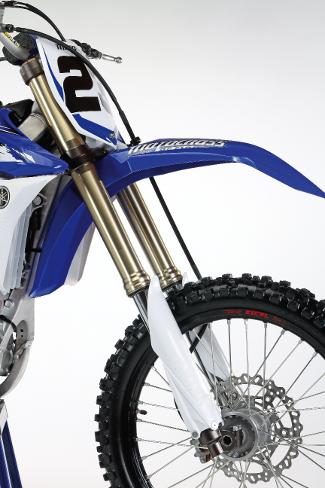 Forks: By getting the forks to stay higher in their stroke the Kayabas not only work better, but help the YZ450F handling.
|
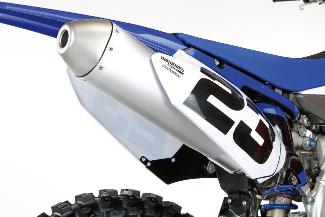 Bazooka: In order to meet new sound standards the mufflers are getting longer and the cores are getting smaller. |
A: If we had our druthers (and we do), these are the things we would change on the 2012 YZ450F.
(1) Gearing. We don’t like the stock gearing on the 2012 YZ450F. The short powerband of the fuel-injected engine seems to aggravate a gap between second and third gear. Every MXA test rider complained that the bike would fall off the pipe on the second-to-third shift in heavy loam, sand or going up hills. The fix? Gear it down. We ran either 13/49 or 13/50 to help give the bike more oomph out of corners. The stock rear sprocket is a 48.
(2) Shock linkage. The YZ450F has a stinkbug orientation that makes the chassis feel out of balance. We swapped out the stock rising-rate linkage for a longer Pro Circuit arm. The new link lowers the rear end, which allows a wider range of setup options in terms of fork height, race sag and suspension settings. For more information, go to www.procircuit.com.
(3) Exhaust pipe. This bike likes aftermarket exhaust pipes?and the 2012 YZ450F’s smaller-diameter muffler core is not the hot setup for producing the best low-end power…as the KX450F’s superior number from off idle all the way to 8500 rpm proved..
(4) Power Tuner. You gotta love Yamaha’s GYTR Power Tuner. It won’t produce more horsepower or more top end, but it allows the rider to advance and retard the ignition to produce different styles of power. Additionally, it can change the amount of fuel delivered by plus or minus 21 percent. Last year’s Power Tuner will work on the 2012 model. As a rule, we used the Power Tuner to change the low-to-mid transition.
(5) Front brake. Yamaha’s front brake is adequate, but not much more than workmanlike. We swap the stock 250mm front rotor for a 270mm oversize brake kit.
(6) Airbox mods . We run Twin Air’s $250 Power Flow airbox. It uses a green, weenie-style air filter that flows more air, makes less noise and is slightly easier to change.
Q: WHAT IS THE BEST ATTRIBUTE OF THE 2012 YAMAHA YZ450F?
A: Reliability. If a bike can be broken, the MXA wrecking crew will break it. Of all the 450cc motocross bikes sold, the YZ450F is the most reliable. If you are looking for a trouble-free race bike that runs and runs and runs, the YZ450F is the best bike for you.
Q: WHAT DID WE HATE?
A: The hate list:
(1) Airbox. Bank of America should take a close look at the YZ450F airbox design before they build any more vaults. Nobody can crack into this thing without a stick of dynamite. Having to remove the seat, six bolts and flip the gas tank up to change a filter seems like overkill.
(2) Side panels. We resorted to riveting the number plates onto the top part of the side panels to keep them from separating. This is not thermowelding at its best.
(3) Textured plastic. The textured pattern on the black radiator shroud’s plastic grows fuzz after hard use.
(4) Weight. This bike would be so much better at 230 pounds.
(5) Brakes. There is no shame in not having the most powerful brakes, but there is no honor in having weak brakes.
(6) Shifting. The YZ450F has always been reluctant to make the upshift from second to third. The engineers think they have found the problem. They haven’t.
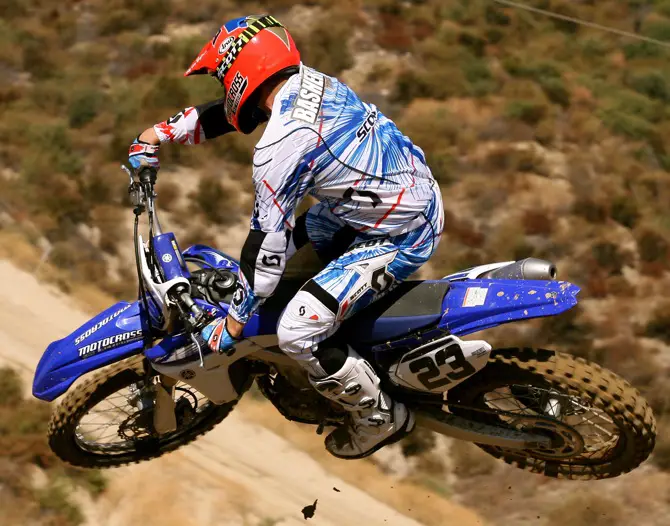
Q: WHAT DID WE LIKE?
A: The like list:
(1) Reliability. MXA test riders are hard on bikes. The only machine that can take the abuse without a squawk is the YZ450F.
(2) Spring preload. Adjusting the shock preload on most modern motocross machines is difficult (if you can even find the preload rings). Not so on the 2012 YZ450F. The backwards engine makes it easy to get to the shock.
(3) GYTR Power Tuner. Not as complex as the other brands’ reprogramming tools, the GYTR Power Tuner is much more likely to get used. It is a small, relatively inexpensive, self-contained device that allows the fuel map and ignition timing to be changed in 30 seconds.
(4) Sound. It’s quiet. Why wouldn’t it be?
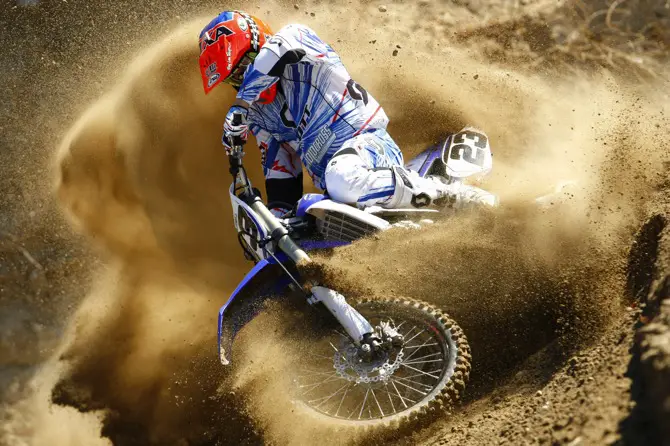
Q: WHAT DO WE REALLY THINK?
A: We liked it a lot better than the 2011 YZ450F. Yamaha is between a rock and a hard place with the 2012 YZ450F. It was introduced with much fanfare in the heat of the recession. Although it sold well in 2010, sales fell off as unemployment went up. The conundrum for Yamaha was whether or not to spend precious cash remodeling the totally new YZ450F design?with full knowledge that bike sales were sinking.
What would you do? Yamaha, along with KTM, Honda and Suzuki, elected to stand pat mechanically, hoping that the market will improve for the 2013 model year. If you accept the financial reasons for the 2012 YZ450F being a modestly reheated version of the 2011 YZ450F, then you are a potential buyer?and a happy one if you owned a 2009, 2010 or 2011 YZ450F






Comments are closed.